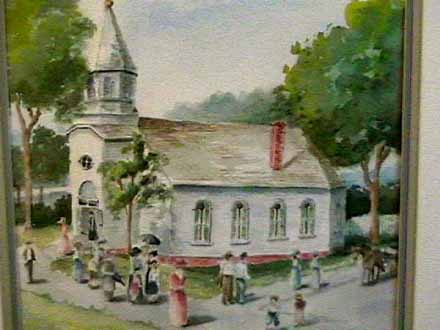
The Holy Rosary Church, Plattsmouth, Nebraska

This painting was commissioned by Joseph A. Kenny to depict what the church looked like in circa 1890. Painting by Barb Linder, Plattsmouth, Nebraska
Notes from the files of Joseph A. Kenny
* Until 1891, the Catholics of Plattsmouth, NE were members of St. John Church. The Czech's saw the need of having their own church, in their own tongue, that's when Cyrill Janda formed a committee with himself as president, his brother Tomas, as treasure, a fellow named Anton Toman as vice-president. They raised the necessary money and purchase three lots from a Joseph Svoboda, in the Dukes addition, Block, 19, in Plattsmouth, NE, and built their church in 1890 for $2400, and named it "The Holy Rosary Catholic Church" They now had a church in which the services were in their own language. The Church was erected on June 1, 1891. It was 70 feet long and 40 feet wide. On October 4, 1891, the church was dedicated by Father Bonacum and assisted by Father Carney and Father Bouska. The Church still stands today at 1610 First Avenue, but is no longer operating as a church, and is totally gutted. There are some spectacular stained-glass windows, each one having a member of the church committee member placed on it.
Father Carney was the first priest to have a mass in the uncompleted church.
Father Bouska was the first priest but did not stay long. Father Bor was his successor. When the church first opened, the older men served as alter boys. Men like Cyrill Janda and Joseph Jelinek filled in as alter boys till young men could be trained. Michael Warga Jr. was the first boy to serve as alter boy, followed shortly after by Thomas Janda and Anton Kanka. The church bell was rung every morning, noon and evening.
The first baptism in the new church was the daughter of John and Emma Chyba (Hiber) with their daughter Marie.
The first organ was used for 25 years and after which the church was badly in need for a new one. So the Holy Rosary Church sold chances for it and the lucky winner was the late Josephine Kalasek, but unfortunately, the Kalasek's house broke out in fire and the organ perished.
Although the church was formed by people that hardly had any money, it later became one of the more beautiful and successful churches in Plattsmouth. Frank Janda, brother to Cyrill, assisted in the construction of the Holy Rosary Church, and was highly credited with the interior arrangements and decoration.
During the first 50 years of the church, many statues, Sanctuary lamps and other miscellaneous things were donated to help beautify the churches interior.
Our Lady of Lourdes statue stood as a memorial to Frances Absolon Janda, who was the second wife to Frank Janda.
The Statue of Our Lady of the Most Holy Rosary, which the church was named, stood and was given by Frank Janda, who was an Omaha Mortician. It was place in the center of the main altar.
The first and second sets of the Stations of the Cross were donated by Cyrill Janda. Later in 1945, new Stations of the Cross were donated by the children of Cyrill Janda.
The organ which was placed in the Chapel was a gift from Mr. and Mrs. Anton Toman. Also in the early days Mr. and Mrs. Anton Toman and Mrs. Joseph Svoboda donated a statue of an angel holding a candelabra.
The use of the Czech language was gradually discontinued and on August 26th, 1943, the last homily in Czech was delivered at the Funeral of Thomas Sedlak.
Cyrill Janda was the first organist and continued to be organist for 42 years after-which his grandniece, Dorothy (Svoboda) Pilny, became the organist and served the next 40 years. Regular members of the Choir were Cyrill's daughters, Antonia Janda, later Pitz.
The following tribute was paid to Cyrill for all his
efforts with the church by Father Matej Bor, in the late 1890's:
"As long as our church has been standing, you have
played the organ; Even though after work you are so worried, your willingness is
without limits. You never ask for rewards for your tasks, your souls generosity
was fully satisfied that our faith would conquer.
Always God's work you tried to improve, even though many
times you got no thanks for your efforts, but you never cared, you toiled on.
The chorus of the church singers you trained with your
example of diligence, Church music with your labors you preserved. Today with
your labors we recall. Today in your ring of friends and relatives we see, yet
all are heartfully wishing you; that for many years you would play yet in our
church. May God reward your work with luck, bliss and let you reach
Heaven."
By January 1, 1941, the church was free of debt, until near its final years.
The closing was a result of the lack of priests in the Lincoln diocese and a lesser population in Plattsmouth. (in 1891 there were 8392 people in Plattsmouth and in 1973, there were 6371 people.)
The church's last mass was offered on 6 Sept. 1973.
References came from various articles that I have collected from "The Plattsmouth Journal" and from Joe Kvapil, a "Plattsmouth, Bohemian Town" expert